Active vs Passive reading
You will use active and passive reading techniques throughout your language journey. When you first start reading Japanese, most of your time will be spent actively reading. Active reading is when you actively look up lots of words, break down the grammar and sentence structure, and make flashcards. Active reading should not be done for long periods, instead, it should be done in about 15 to 20-minute chunks. However, as you continue your language journey, more of your time will be spent doing passive reading. Passive reading is more leisurely, you may look up a word or two but you are not concerned with understanding every detail you read, just the overall idea or story. Passive reading is all about maximizing input and enjoying it, so this can be done for much longer periods, up to several hours. While you may do one of these more than the other depending on what your goals are, it is important to do both, as they will both increase your reading ability in different ways.
In the article, you will find several tools to help you with both your passive and active reading. Depending on what and how you like to read, you may find some of these tools more useful than others. I encourage you to look through all of them to see what fits your needs best. If you’re looking for information about reading resources, such as where to find Japanese books and articles, click the link below.
It’s also a good idea to have a good Japanese-English dictionary on hand, so you can look up examples and definitions for tricky words.
All Platforms
Immersive Translate
Immersive Translate is a powerful extension available on all popular browsers. It allows you to read web pages and documents in two languages. This is great for language learners because it lets you check your comprehension as you read. Start by downloading the extension for the browser of your choice.

After you download the extension, a pink bubble will appear on the right side of your screen. When you click on this, it will add an English translation underneath each paragraph on the website. This is very useful when you first start learning to read, especially if you combine it with another extension like Yomitan that gives you a word’s definition and pronunciation. You’ll learn more about Yomitan later.

As your reading abilities improve, I recommend only translating the paragraphs you struggle to understand. To translate one paragraph at a time, click on the gear icon under the pink bubble to access your settings, then make sure you have “Hover” enabled and the other two options disabled like in the picture below. Now when you Ctrl + click on a paragraph it will only translate that paragraph. If you are on mobile, it will be a right swipe to translate a single paragraph.

Here is an example where only one paragraph is translated. As your reading abilities improve, you should only use translations as needed and try not to rely on them too heavily.

To add translations to PDF or ePub, click on the PDF/ePUB button in the settings.

Now you can upload any Japanese PDF or ePub to which you would like to add translations. I recommend using books or articles you’ve downloaded. Also, I generally prefer to use ePubs since they allow for paragraph-by-paragraph translation. If your book did not come as an epub, you can use a converter to change the format.
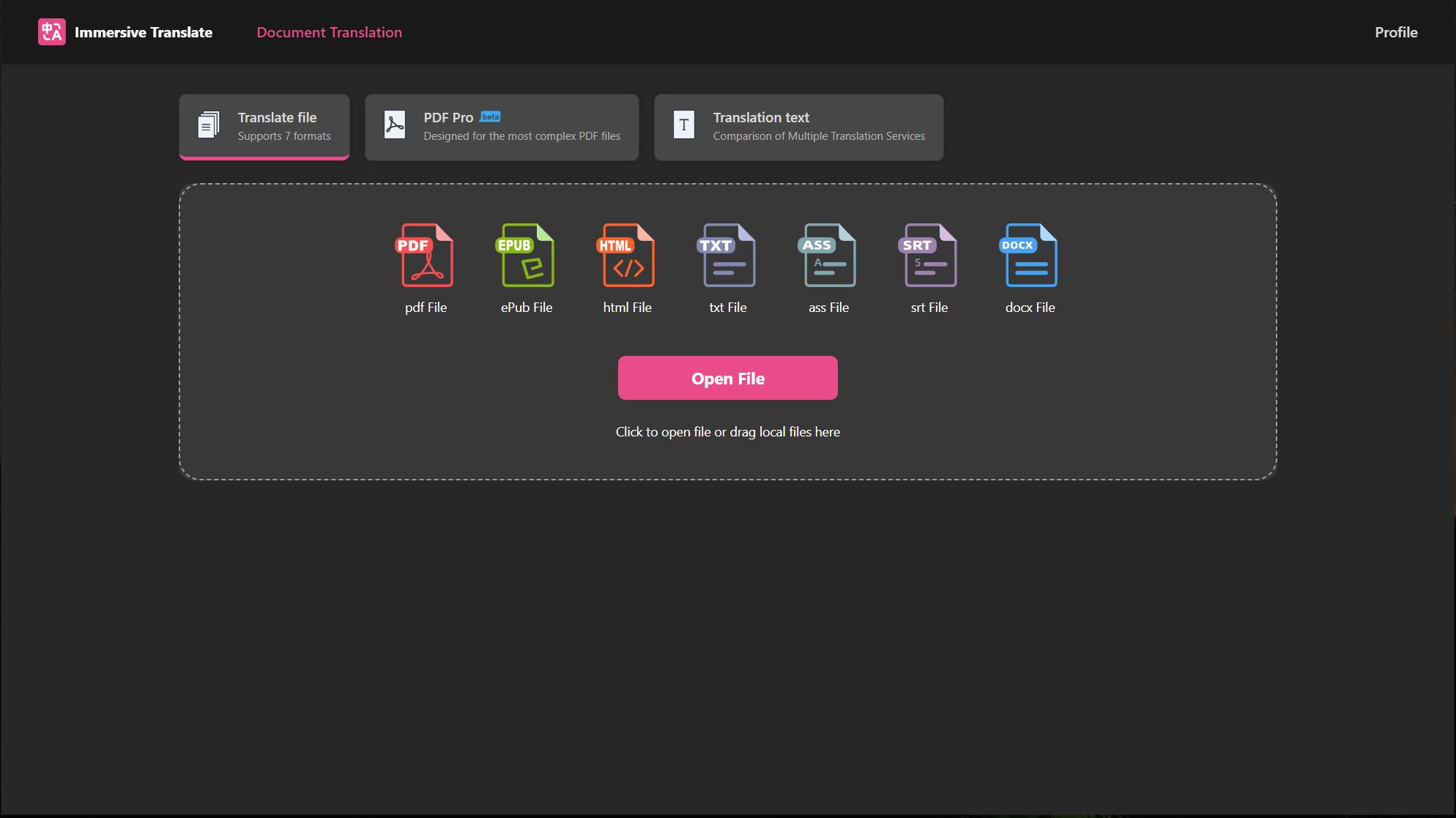
Once you’ve selected your document, click on “translate.” It may take a few minutes to prepare and translate your document depending on your internet connection and the size of the document, so be patient. Also, because it’s a machine translation, it won’t always be perfect, so you shouldn’t overly rely on the translation. It’s just there as a way to support your comprehension as you read. You should try to understand the Japanese on your own first.
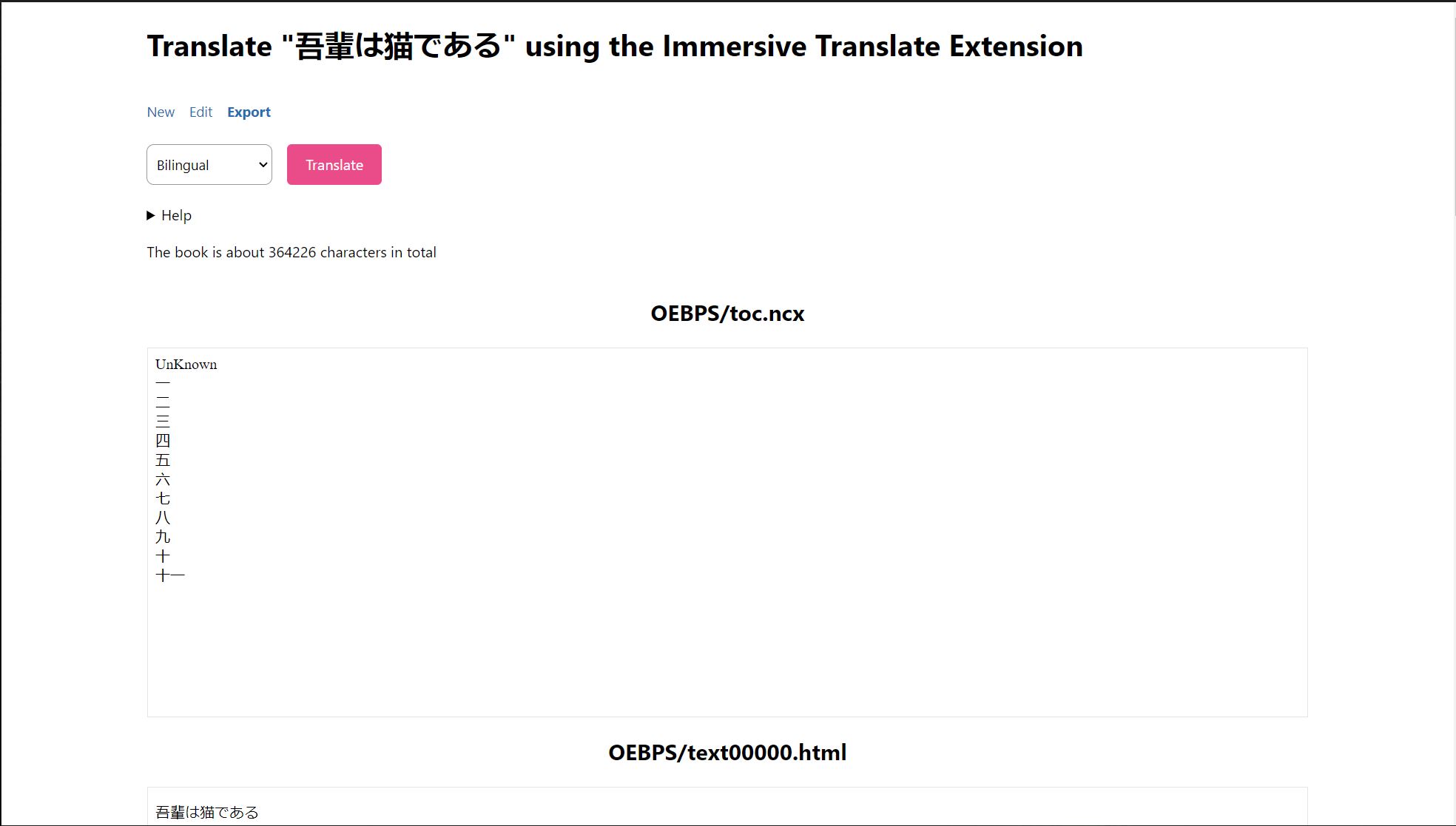
Once your document is done, it will automatically be downloaded to your device. To read the document, you can use any reading program of your choice, but I highly recommend ReadEra if you tend to read on your phone like I do. If you like to read on your laptop, I recommend Aquile Reader.

Japanese texts are usually written from top to bottom in ReadEra, so to change the orientation, go to the settings, then click on “text direction” and select “left to right.”

You can also highlight any words or sentences you would like to see the pronunciation or definition of.
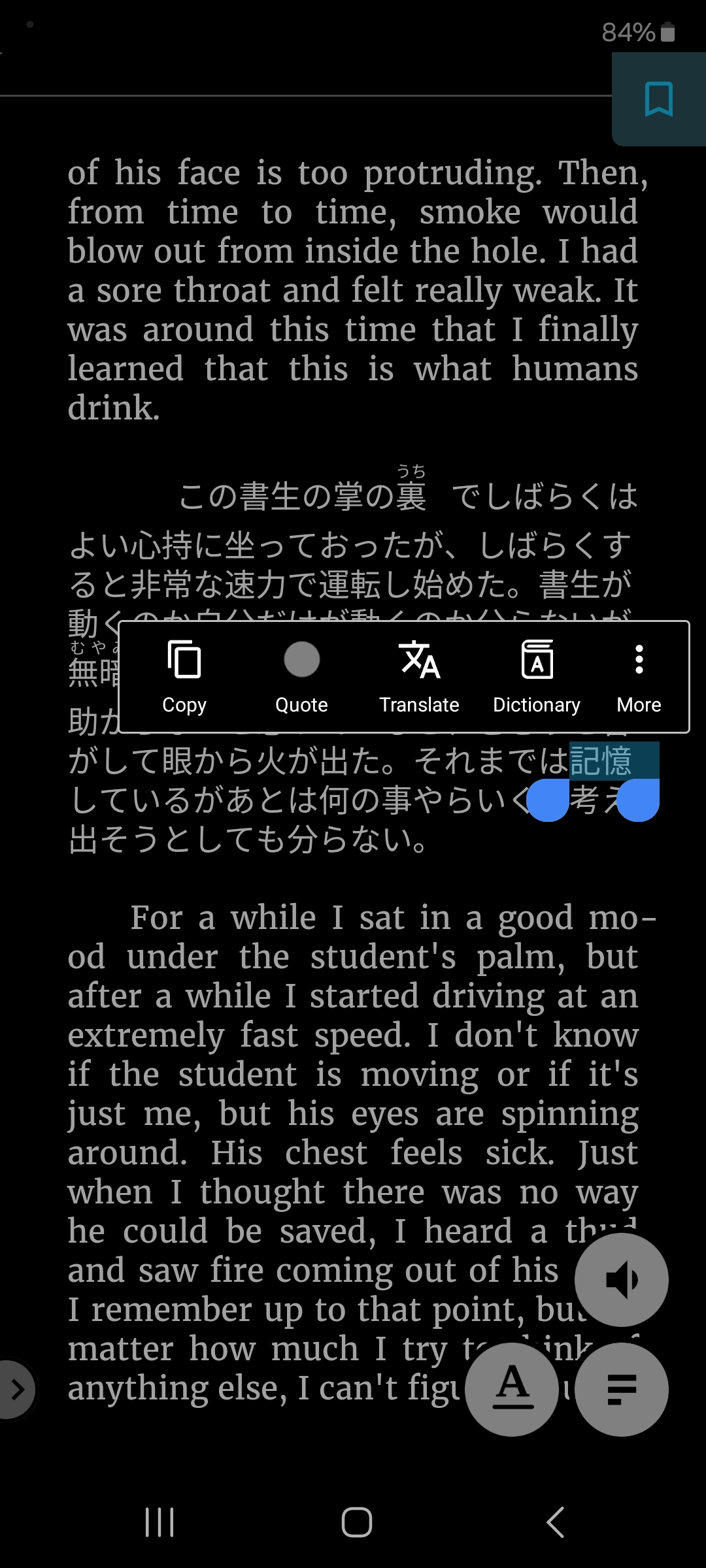
When you use the dictionary option on a single word, the definition will pop up at the bottom of your screen along with the pronunciation in hiragana.

When you use the translation option, Google Translate will give you a full translation with the romaji pronunciation.

PC
Yomitan (previously Yomichan)
Yomitan is a pop-up dictionary extension for Google Chrome that makes it easier to read webpages in Japanese. Once the extension is installed, all you need to do is Shift + Click a word, and the English translation will pop up. Yomitan can also be connected to Anki to quickly create vocabulary flashcards. Yomitan is great for learning new vocabulary, but it won’t help you much with grammar or full-sentence translation, so it is best used with texts around your reading level. The video below goes into detail on how to set up Yomitan (previously Yomichan) and connect it to Anki. If you prefer written instructions for setting up Yomitan, then you will find those below the video.
After you open the Yomitan link and are in the Chrome web store, start by clicking on the blue “add to Chrome” button in the upper right-hand corner. Once it is installed, the button will change to say “remove from Chrome.”

Next, go up to your toolbar and click on the Yomitan extension, then press the gear icon to go to settings.

In settings, scroll down and turn off the welcome guide. This will stop it from popping up every time you open Chrome.

Next, we need to install a dictionary. Click the link below and download the Japanese-English dictionary. Do NOT unzip it or open it. Just download it.

Now, in your Yomitan settings, click on “configure installed and enabled dictionaries.” Select the dictionary you just downloaded, and press ok. It may take a few minutes to install it.

Once the dictionary is installed, you can Shift + Click over any Japanese word and it will give you the reading and definition.
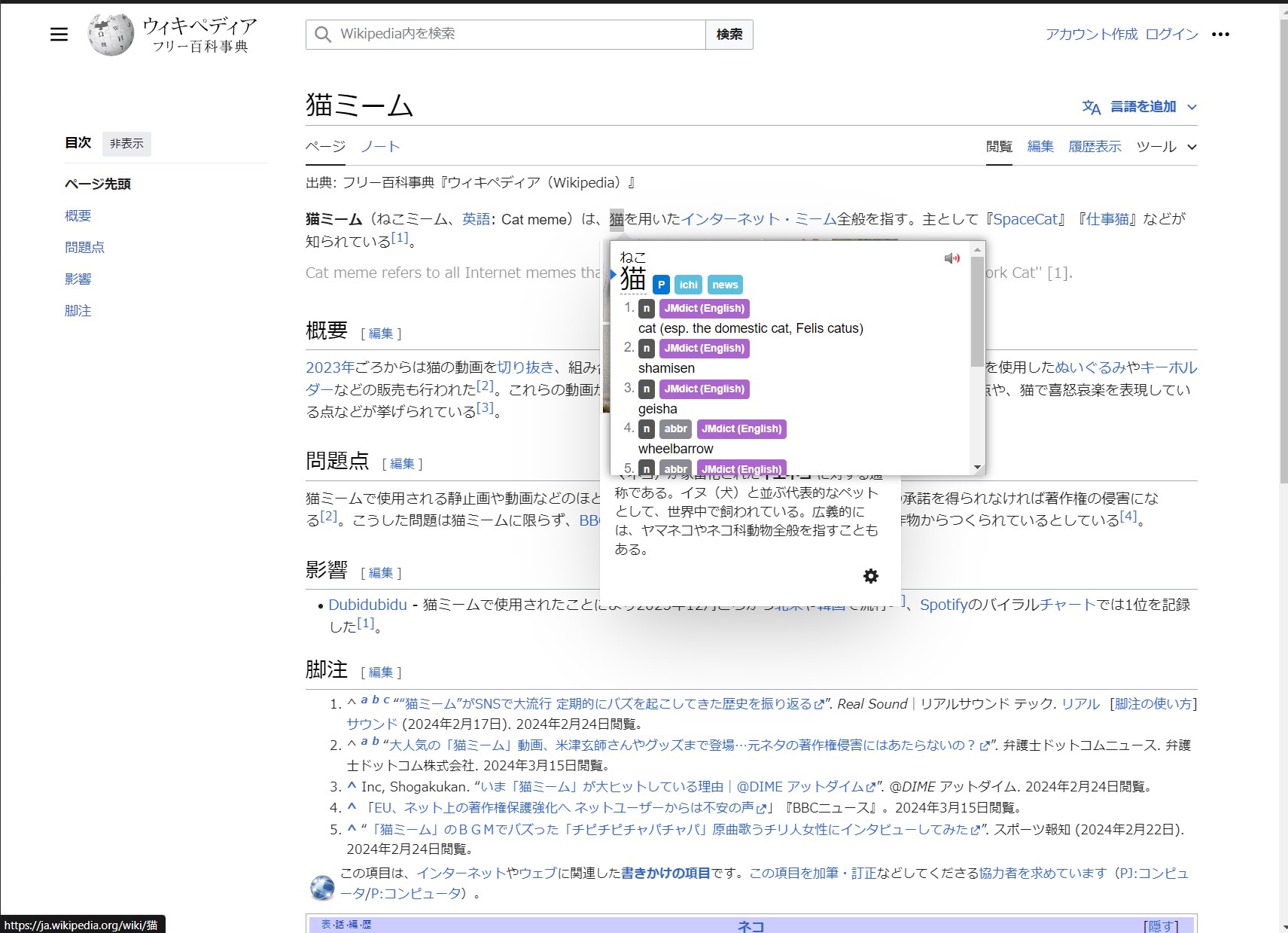
For more information on connecting Yomitan to Anki, watch the video above.
Tsureader
Tsureader is a free browser-based ebook reader that is compatible with Yomitan. After opening tsureader, upload any Japanese ebook you want to read in a epub format.

Make sure you have Yomitan enabled, then shift + click on any word to look up its translation.

Built-in Translator
Most browsers have a built-in translator. All you need to do is highlight what you want to translate, right-click, and then select “translate selection to English.” Depending on your browser it may just say “translate” instead of “translate selection to English.”

The translation for your sentence should then pop up at the top of your page. Unfortunately, it doesn’t give you the pronunciation, so this method should be used in combination with Yomitan.

Mobile
Oyomi
Oyomi is a free e-reader app that allows you to easily read epubs in Japanese.

The app is originally in Chinese, but it does have English support. Sometimes when you first download the app, it will be in Chinese. If this happens first click on the 学习 icon in the bottom right corner.
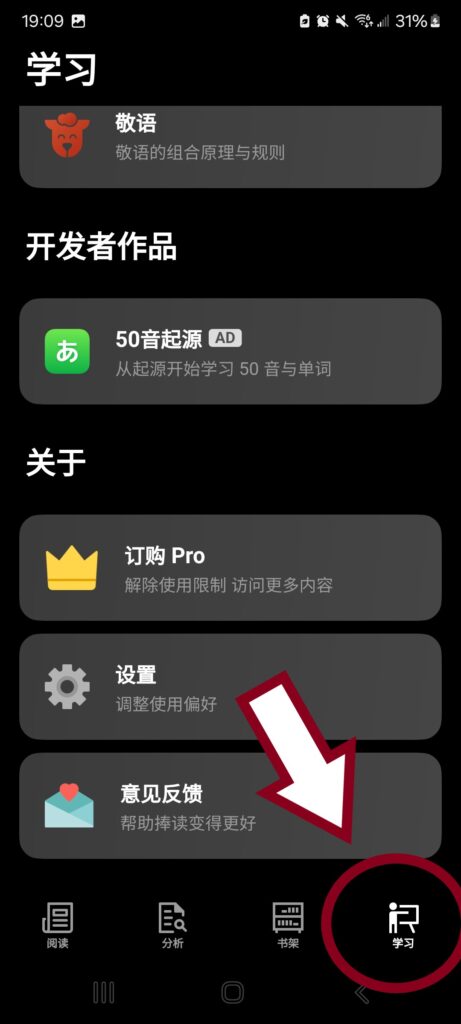
Next, click on the button with a gear icon. This will take you to settings.

Finally, click on 语言 and switch it to English. Once you restart the app it should all be in English.

Once the app is up and running in English, you can add an epub to your bookshelf or copy the link of an article into the analyze page. Below is an example of what an epub for a book looks like when opened in the app. Press “analyze” to break down a sentence and take a closer look at it.

On the analyze page, your sentence will be broken down into its components. The parts of speech will all be marked and you can tap a word for more information about it. To turn off the colored highlights, tap “pos mark” in the bottom right corner.

When you click on a word, you will be able to see its reading, form, part of speech, and definition. This is also where you can “star” words and save them to your vocabulary study list. Saved words can be reviewed as flashcards by going to the study page and then pressing “review.”

In analyze mode, you can also have the sentence read out loud or translated. If you press study, it will present you with flashcards of all the words you’ve started in that sentence.

Android
Jidoujisho
Jidoujisho or Automatic Dictionary in English is the most useful app for reading Japanese and effortlessly turning new words in Anki flashcards. The app allows you to use a pop-up dictionary to translate imported texts and videos with subtitles then automatically generate high-quality flashcards for Anki. To get Jidoujisho start by downloading the most recent version of Yuuna on the Jidoujisho Github page. In the image below, the most recent version is 2.8.

After you’ve selected the most recent version, click on the top download link. The arm64 version should work with most phones, but if your phone has issues opening the installer, try one of the other versions.

Install the app by clicking on the downloaded apk file and then clicking “install.” It will look like the image below as it installs.

Now you will need to download a dictionary for the pop-up dictionary in Jidoujisho to work. Follow the link below and download the JMdict Japanese-English dictionary.

In the Jidoujisho app, click on the three dots in the upper right corner, then select “manage dictionaries.”

Ensure “Yomichan dictionary” is selected, then click “import.”

Next, find “my files” to get to your downloaded files.

Select the dictionary you just downloaded, then click “done.” Once the dictionary is imported, you can close the “manage dictionaries” window.

Now you need to import what you want to read by clicking on the book icon in the upper right corner. If you’re looking for reading material, check out the linked post.

Once you’ve imported the book or text you want to read, open it and click on any word for an instant translation.

You can change how the text in your reader looks by going into the “settings” next to the “import book” button. I prefer to read horizontally, and I like the app to automatically bookmark where I am, so I changed those settings. You can play around and see what you feel most comfortable with.

Now we’re going to set up Jidoujisho to automatically generate Anki cards. If you are unfamiliar with Anki, click the link below for more information. Close out of the reader and go back to the main page, then click on the three dots in the upper right corner again but select “export profiles” this time.

Ensure that “standard” is highlighted and the card type is “jidoujisho kinomoto.”

If you want to change what fields are displayed or how your cards look, click on the three dots next to “standard” and then on “edit” to change the card fields. However, this is not necessary, and the default settings will work just fine. Close out of the “export profiles” window when you’re done.

Now when you read and click on a word, you can use either of the red buttons in the top right of the definition to create a flashcard. The one on the left will instantly create a card and the one circled below on the right will allow you to see what the card will look like before it is created. I recommend using the second option, especially in the beginning so you can choose what image goes with each card.

In the card creator, you can choose which image you want displayed on the card and alter any information to suit your study style. The first time you export a card, you’ll need to select which deck you want the card to go to or you’ll get an error message. In the image below, I’m adding my cards to a deck called Jidou Cards. When you’re happy with the card, click “create card.”

Now when you open Anki, you will have cards that look like the one below. These flashcards are amazing for helping you quickly pick up vocabulary in context. Jidoujisho can also create cards from videos with subtitles, but I rarely use that feature since videos must be downloaded on your phone to work, and I prefer streaming.

Built-in Translator
To use the built-in translator on your phone for translating unselectable text such as that in manga or games, hold down the home button at the bottom of your screen. Note: This may not work on some older Android devices!

Next, select the translation button that appears in the bottom right corner.

To ensure you only translate what you need, set the translation so it translates from Japanese into Japanese. This will allow you to select specific words and sentences without translating the entire page.

Next, highlight the word you want to translate, and it will automatically pull up the Google search results for that word. If you want the actual translation, click on “Translate.” Keep in mind that you may need to zoom in before activating the translator if the text is small.

You can also select whole sentences to translate them!

To use the built-in translator on your phone for translating articles and text on web pages, simply highlight the text you want to translate, scroll through the options until you see where it says “translate,” and click it.

After you translate the text, you will be able to see the English translation and pronunciation of the Japanese. I usually use this method for single words and only translate full sentences when I can’t understand them at all.

Instant Translate
Instant Translate allows you to copy and translate text you normally wouldn’t be able to such as that in images, apps, and videos. After downloading the app, you can turn it on either by opening the app and pressing the start button or by putting the widget for the app in your instant access bar and turning it on from there. It will then ask for permission to record your screen, which you must say yes to in order to use the app.
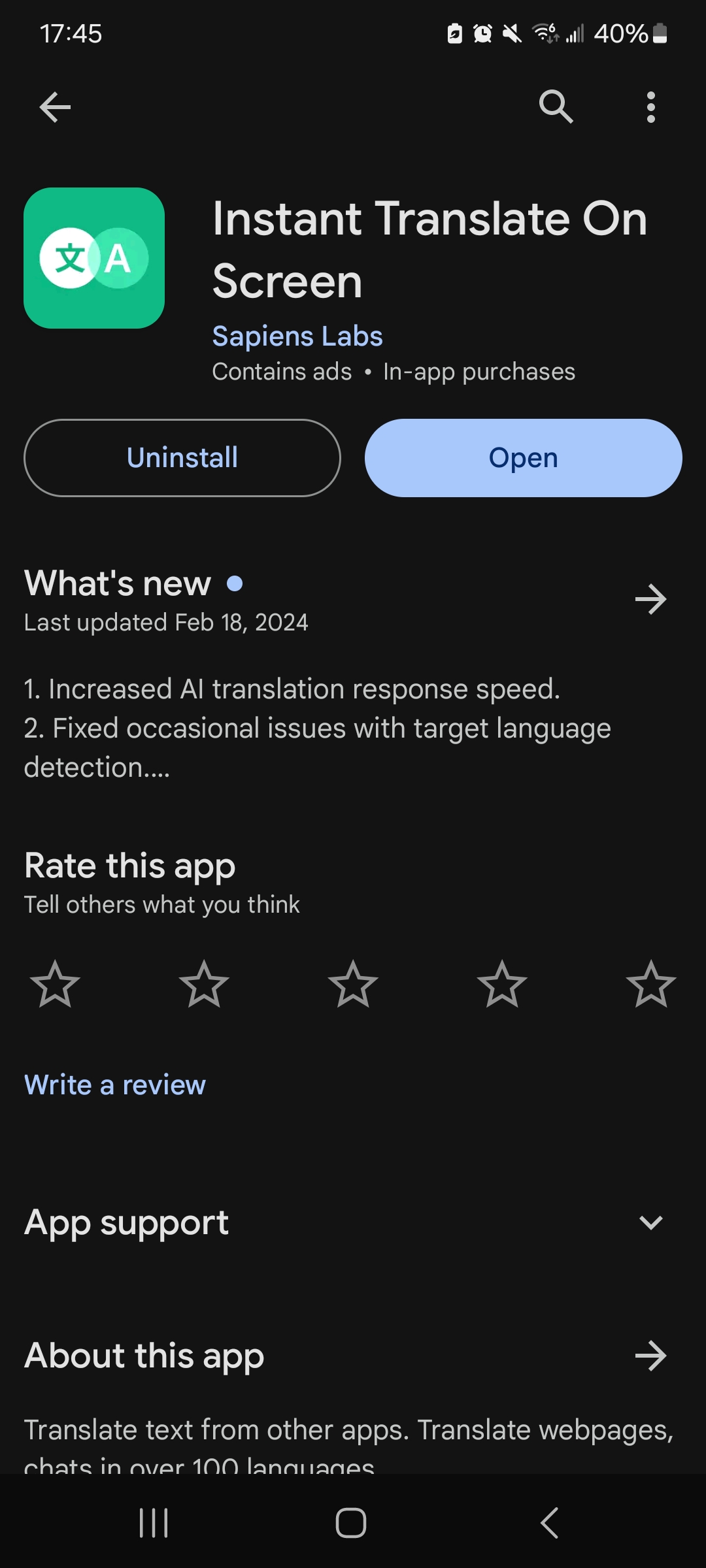
Once the app is running, it will appear as a green circle on your screen. Tap the green circle to open the translate menu. First, go to “change language” and make sure it is set to translate from Japanese into English. You should also download the language packs for both languages by clicking on the download button to the right of the language’s name. Next, to translate Japanese text, you will mostly use “global translate” and “region translate.” Global Translate will translate all the text it can find on your screen, while Region Translate will allow you to select the section of text you want to translate. Region translate is often better at grabbing text than global translate, so I tend to use it more often.

When you use global translate, your screen will look like the image below. Tap on the section of text you want to look at more closely, and the translation window will pop up. You can see even more detail if you click on the expand button, which is the two arrows on the bottom right. You should look at what you’re translating in more detail because the translator won’t always get everything 100% right, especially for a language like Japanese. This doesn’t matter as much if you’re mostly using it to look up words and for quick translations. If you’re using the translator to translate every sentence of what you’re reading, you need to switch to reading something easier.
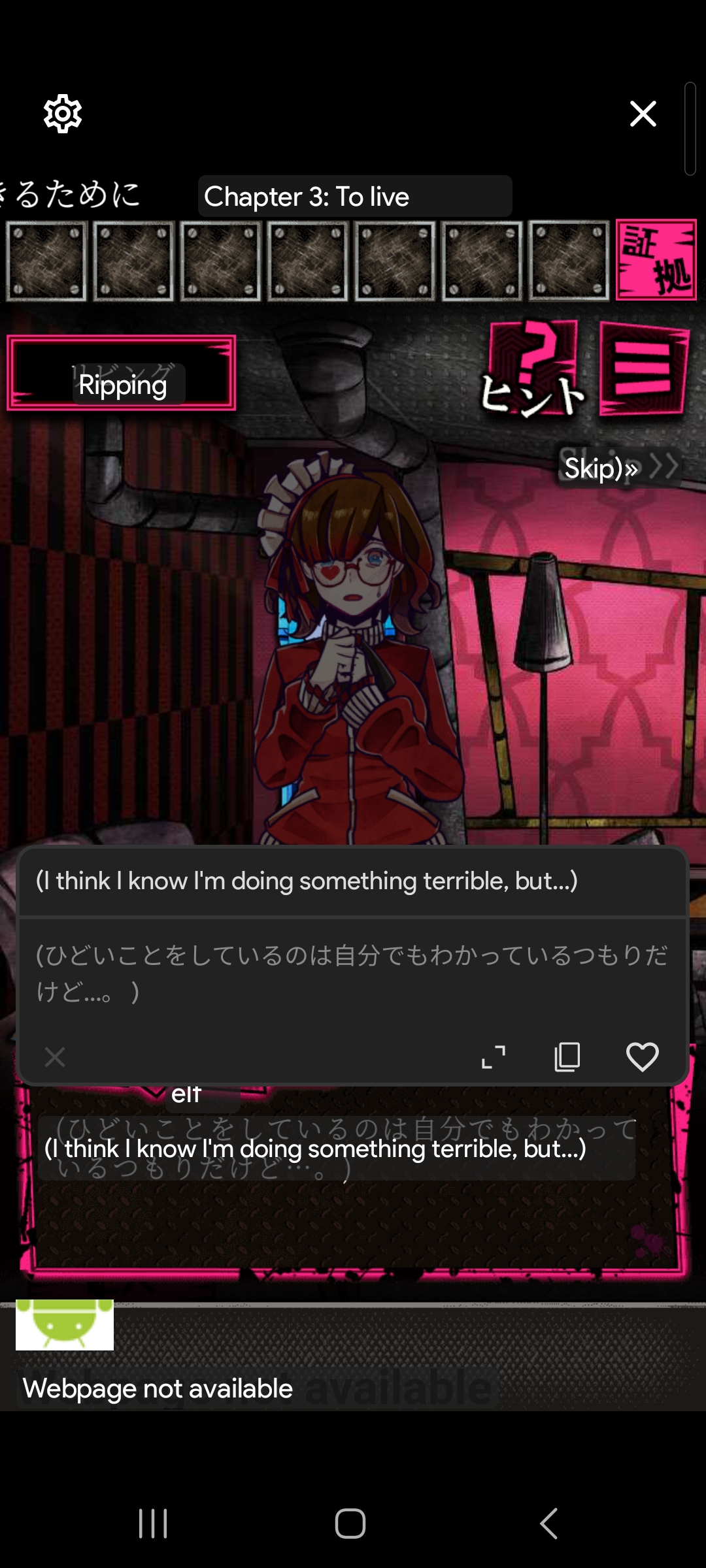
When you expand the translate window, you will see more options. The first button will break down the sentence into pieces. You can click on any of these words to get more details, including pronunciation, translations, and etymology. The next button is for copying the text. You may want to copy the text into a different app, such as a Japanese-English dictionary or Anki, to make flashcards. The other two buttons allow you to listen to the sentence and search it on Google respectively.

When you click on a word, it will take you to the page below. Close the Chinese information by tapping the little arrow on the left side Chinese. Now you can see the Japanese information for this word. For a noun, you will see the pronunciation, pitch accent, kanji meanings, and definition.

For words that have multiple forms, such as adjectives and verbs, the information won’t be so straightforward. Instead, it will give a breakdown based on the kanji. You will see the meaning of the kanji as well as several examples of its onyomi and kunyomi readings.

IOS
Built-in OCR and Translator
IOS has powerful built-in OCR and translation features that allow you to easily select a word and translate it even if it’s part of an image or normally unselectable text. All you have to do is highlight a word and tap “translate” in the pop-up menu. In this pop-up menu, you can also copy the word if you would like to move it to another app like Japanese or Anki, to make flashcards.

After pressing “translate,” it will then show you a translation. You can also listen to the pronunciation of the word or sentence you have selected.

Manabi
Manabi is an e-reader and Japanese study app that can assist you with reading Japanese articles and novels. While some of its features are behind a paywall, the free version of the app still allows you to read articles and documents of your choice and has all of the features you need.

When you first open the app, you will see your stats for how much you have studied with the app. Beneath that, you will see an area where you can upload your own files into the app. I recommend mostly using the app for reading novels or articles that you upload yourself.

You can also scroll down a little farther to see Japanese texts provided by the app. This is useful if you are looking for something easier or not sure what to read.

When you open the reader, it will look like the image below. The reading mode can be changed in the settings by tapping the gear icon in the upper right corner if you don’t like how it looks. You can also see a word’s definition and reading by tapping on it.

iTranscreen
Unfortunately, not all apps work with the built-in OCR. In some apps, especially games, there is no way to copy or translate text. This is where iTranscreen can be very helpful. It allows you to translate text you normally wouldn’t be able to translate.

I’ve found the app is most effective when you use it in game mode. Just make sure it’s set to translate from Japanese into English, then press “start.” You should then see a pop-up that you can use to select the text you want to translate.

Paper Books
Google Translate
With the OCR capabilities of Google Translate, you can easily take a picture of a word or sentence you don’t understand and quickly get the translation and pronunciation. Start by opening Google Translate and pressing the camera button in the bottom right corner.

Next, take a picture of what you want to translate, then at the top of your screen, make sure you have it set to “show original text.” Showing the original text is very important for learners because it will allow you to copy words and select just the sections you want to translate. Also, the OCR is more likely to mess up the translation if you don’t manually select the text.

Next, highlight the word or sentence you want to translate, and it will automatically show you a translation. If you would like to make flashcards out of the words or sentences, you can then copy them into Anki or your Japanese-English dictionary of choice.







